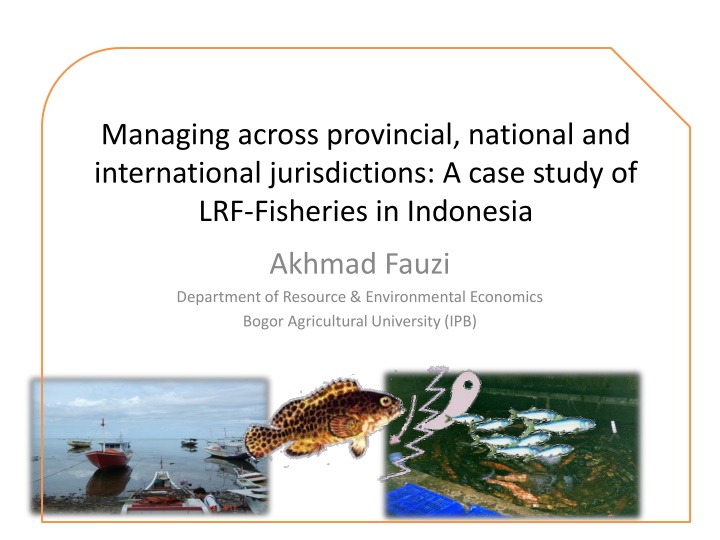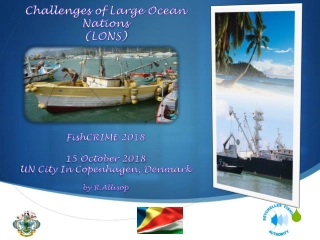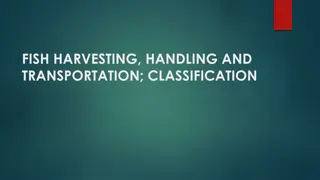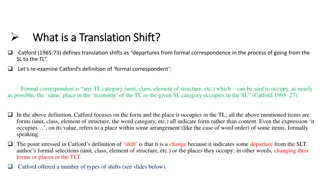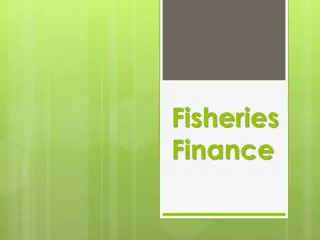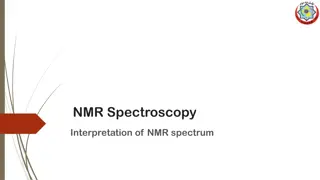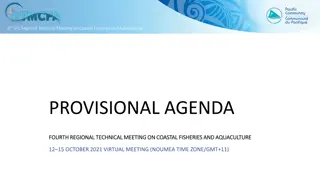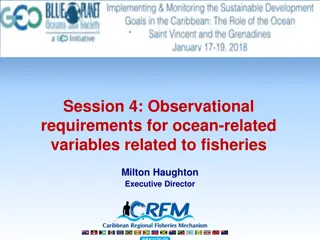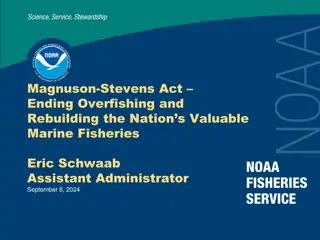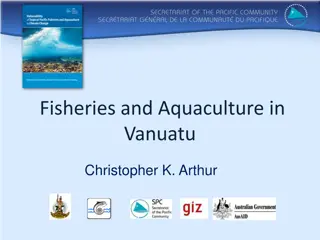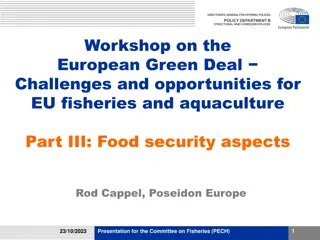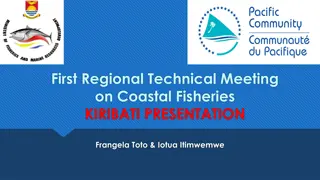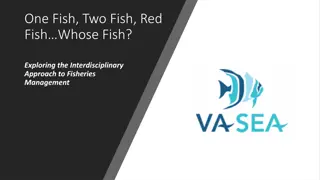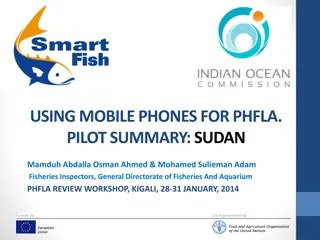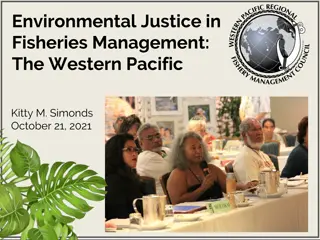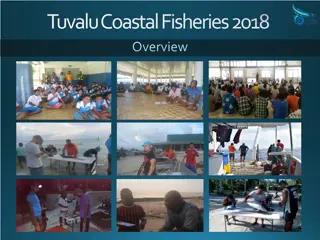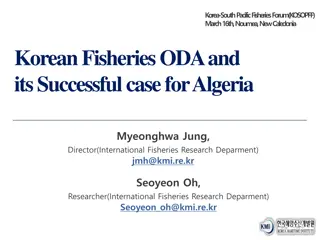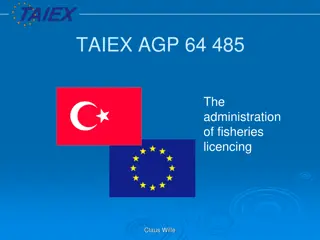Managing LRF-Fisheries in Indonesia: Challenges and Policy Shifts
Indonesia's LRF-Fisheries face challenges from ecological, economic, and social perspectives, with concerns over sustainability due to destructive practices. The management of fisheries has shifted from centralization to decentralization, leading to conflicts over jurisdiction. Despite the lucrative nature of the business, issues such as coral reef destruction and the lack of a comprehensive policy pose challenges to the industry's sustainability.
Download Presentation

Please find below an Image/Link to download the presentation.
The content on the website is provided AS IS for your information and personal use only. It may not be sold, licensed, or shared on other websites without obtaining consent from the author.If you encounter any issues during the download, it is possible that the publisher has removed the file from their server.
You are allowed to download the files provided on this website for personal or commercial use, subject to the condition that they are used lawfully. All files are the property of their respective owners.
The content on the website is provided AS IS for your information and personal use only. It may not be sold, licensed, or shared on other websites without obtaining consent from the author.
E N D
Presentation Transcript
Managing across provincial, national and international jurisdictions: A case study of LRF-Fisheries in Indonesia Akhmad Fauzi Department of Resource & Environmental Economics Bogor Agricultural University (IPB)
Brief overview of Indonesia LRFF Indonesia is one of the key players in LRFFT to international market Sustainable fisheries management, including LRF has become commitment of Indonesian Government LRFF in Indonesia has been practiced for several decades, with different scale of economics and different geographical areas Indonesian LRF faces enormous challenges from ecological, economical and social perspective There has been a geographical shifting of Indonesian LRFF from dominated western part to eastern part of Indonesia
LRFF is a lucrative business involving various level of market chain There has been concern over sustainability of Indonesia s LRFF due to destructive fishing practices and IUU fishing To some extent, benefits received from LRF are outweighted by the destruction of coral reef Complexity in managing the fishery due to different jurisdiction
Fisheries Policy: from centralization to decentralization PRE-1999 Post-1999 1999 Centralization Decentralization Central government had full authorities to manage the fisheries Growth oriented policy driven Priority was given to increase export of high value species such as shrimp and tuna Old Fisheries Act 1985 Decentralization era 35 of 41 authorities, including managing natural resources are under local government control Conflict of jurisdiction of fisheries over access to and control of resources occurred more often New Fisheries Act 31/2004 -> 45/2009 Soeharto stepped down Reforms of government initiated State of vacuum in fisheries management
Overall challenges of Indonesia LRFF Most coral reefs have been damaged (especially in the western part) myopic decision by fisheries due to limited livelihood in coastal areas MRV mechanism for LRFF in Indonesia is not yet available (e.g what is overfishing indicator for LRFF?, how data support this claim?) A comprehensive Policy for is not yet available LRFF is not priorities especially at regional, local levels. Challenges to fulfill EAFM Source : LIPI, 2005
Challenges in managing LRFF across provincial, national and international : Multi flows of input- output data Mostly local/regional jurisdiction Mostly national jurisdiction National/ International jurisdiction Data on numer of vessels. Fish caught Unrealibale reporting Fisheries Agencies At local levels, Regionals and Fishers, Traders Statistically Unrecoginzed As LRF Licenses nat national Export market Data IUU Fishing Are not obvious Customs, Other agencies Broken link Export data Difficulty on Stock assessmnet Broken link Difficulty to pin-point LRF export
Typical Fisheries Status and the missing of LRF on the data Fish Stock Status Demersal M/O/F/U Data regarding the resource Shrimp M/O/F/U Area of fisheries Small Pelagics M/O/F/U Big Pelagics M/O/F/U Data on export market Type of fish Volume of Value of export export Shrimp Tuna Seaweed Possibilities of LRF are recorded Ornamental fish Others
IUU Statistics and the link to LRF IUU types 2003 2004 2005 2006 2007 Fishing without license 91 53 26 29 48 Fishing illegally 44 70 36 19 3 Document forgery 6 2 Incomplete document 15 Fishing with electricity 54 1 1 34 Fish bombing 18 9 9 2 1 Transhipment 5 5 11 6 2 Coral stealing 2 1 Operating prohibited gears 7 Red Notes : might indicates directly or directly related to LRFF
Spatial management and planning Some regencies in eastern Indonesia are archipelagic regencies where more than 75% of their area are ocean (eg, Wakatobi and Raja Ampat) Most of the areas are designated as marine protected areas Two different function of regencies : autonomous regency vs conservation regency This creates sectoral conflict making it more challenges to conserve fisheries refugees or implementing EAFM
Socio-economic challenges at local levels Fishing (including LRF fishing)is the last resort due to: Increase in the number population Limited job opportunities on terrestial Stiff competition on fishing related jobs Poverty : a large number of people living under poverty line is coastal areas and at local/regencies levels intrusion of fishermen from other regencies/provinces creating free rider and CCPP (Commonize cost, privatize profit) phenomena
Institutional aspects Various institutions are involved in LRFF at regional levels Conflicting regulations at local levels as LRF fishery encompass many sectors of economy Property rights problem and higher transaction costs create insecure business Giving exclusive concession to private sector (e.g diving business) creates tension between fishers and private sector. As a result fishers have to fish further. Increase in cost of fishing creates spiral upward for myopic behavior for LRF
Local government /regencies initiatives of LRF policies: Success stories Fisher/ Communities Public campaign (Radio, etc Involvement of local communities Partnership with LRFF traders Inclusion of LRF materials into local curriculum Communities surveillance Resource Fishing Market Size control Controlling trade license Control by Forestry Agency for export wrasse (Agency of Natural resource conservation) Setting MPAs (Wakatobi, Raja Ampat) MCS Prohibiting the use of hookah Limit the number of fish caught National/local Acts back up Business units, NGOs, Donors back up Mostly local Acts back up (Perda, Perdes, etc)
Final remarks The government of Indonesia through its fisheries agencies both at national and regional levels has spent considerable efforts to manage the LRFF sustainably : some fail but some succeeded Partnership with private sectors and communities has been encouraged and developed: it s been an on going process and some work Promoting co-management and ecosystem approach to fisheries management has been initiated with cooperation from various institutions through various programs Improvement in data, statistics and scientific information with regard to LRF has been proposed Several regulations have been proposed, including size limit and moratorium proposal for certain species with help from stakeholders Complexity in regional, national and international jurisdictions calls for strong cooperation and collaboration among government units and other institutions
